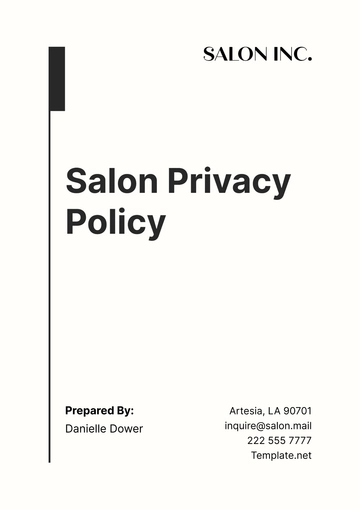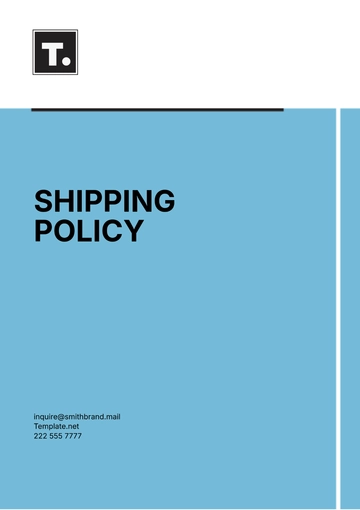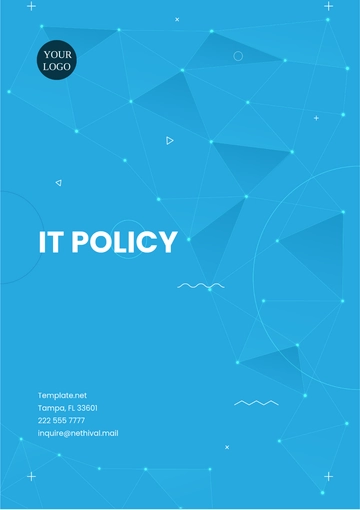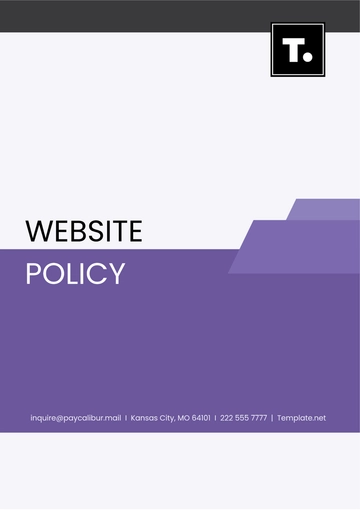Free Sales Policy & Procedure

TABLE OF CONTENTS
I. Introduction
II. Sales Organization
III. Sales Goals and Objectives
IV. Sales Strategies
V. Customer Management
VI. Product Knowledge and Training
VII. Sales Process
VIII. Pricing and Discounts
IX. Quotation and Proposal Process
X. Order Processing
XI. Sales Reporting
XII. Performance Evaluation
XIII. Conflict Resolution
XIV. Policy Compliance
XV. Conclusion
I. Introduction
A. Purpose
The primary purpose of this Sales Policy & Procedure document is to establish a clear, standardized framework for sales operations at [Your Company Name]. By adhering to these policies and procedures, we aim to ensure that our sales team operates cohesively, consistently, and professionally. In the rapidly evolving landscape of [Year], this framework is crucial for achieving our sales goals, maintaining customer satisfaction, and securing our position as an industry leader.
B. Scope
This document applies to all members of the sales team, including Sales Representatives, Sales Team Leads, and the Sales Operations Manager. It encompasses all aspects of sales, from the first customer interaction to post-sale support. Compliance with these policies and procedures is mandatory to maintain our high standards of professionalism and effectiveness.
II. Sales Organization
A. Sales Team Structure
Our sales organization is structured to optimize efficiency and customer focus:
Sales Operations Manager:
Responsible for strategic planning, target setting, and team oversight.
Sales Team Leads:
Manage specific teams of Sales Representatives, ensuring alignment with overall goals.
Sales Representatives:
The frontline sales force responsible for engaging with customers and executing sales strategies.
This structure encourages clear communication, decision-making, and specialization in serving different customer segments.
B. Communication Hierarchy
A clear communication hierarchy is crucial to maintaining alignment within the sales organization. Sales Representatives report to their respective Team Leads, who, in turn, report to the Sales Operations Manager. This structure ensures important information flows smoothly up and down the organization, facilitating effective decision-making and goal achievement.
III. Sales Goals and Objectives
A. Goals
Achieve Quarterly Revenue Targets:
The primary goal is to meet or exceed quarterly revenue targets, which have been meticulously set to align with market expectations and company growth aspirations.
Customer Growth:
Expanding our customer base is critical for our long-term sustainability. Our target is to grow our customer base by5% each quarter.
Customer Satisfaction:
Maintaining high customer satisfaction scores is essential for reputation and repeat business. Our goal is to achieve and maintain a customer satisfaction score of 80% or higher throughout the year.
B. Objectives
Productivity Enhancement:
We strive for continuous improvement in productivity. Our objective is to increase the productivity of our sales team by [X]% over the course of the year. This will be achieved through regular training sessions and the optimization of sales processes.
New Product Launch:
In Q1, Q2, and Q3, we plan to introduce new products to the market. Our objective is to ensure successful product launches, adhering to predetermined timelines, and achieving a strong market presence for these new offerings.
Service Excellence:
Providing top-notch customer support is a cornerstone of our sales strategy. Our objective is to maintain a high level of customer satisfaction by offering fast response times and effective issue resolution. Achieving this objective is crucial for both customer retention and new customer acquisition.
IV. Sales Strategies
A. Customer Segmentation
To provide tailored solutions, we categorize our customers into three distinct segments:
Enterprise:
Large corporations with complex needs and a focus on innovation.
Mid-sized Businesses:
Medium-sized enterprises with balanced requirements of features and cost.
Small Businesses:
Small businesses looking for cost-effective, scalable solutions.
Each segment will receive customized sales strategies designed to meet their unique needs and preferences.
B. Product Focus
Our product focus is in line with the latest market trends of [Year]:
Sustainable Products:
We emphasize the promotion of our sustainable products, which are designed to address environmental concerns. We'll highlight not only their eco-friendliness but also their superior performance, cost-efficiency, and compliance with emerging regulations.
AI-Powered Solutions:
In an era driven by artificial intelligence, we will spotlight the AI capabilities of our products. Our emphasis will be on how these technologies enhance efficiency, productivity, and decision-making, offering a competitive advantage to our customers.
C. Pricing Strategy
Our pricing strategy is designed to ensure that we provide value to our customers while optimizing profitability:
Value-Based Pricing:
We'll adopt a value-based pricing model, ensuring that our pricing aligns with the perceived value of our solutions. This approach allows us to capture the value that our products deliver to customers.
Personalized Pricing:
For large enterprise customers, we will provide personalized pricing options based on their specific requirements and budget constraints. These tailored pricing solutions enable us to accommodate the individual needs of our most significant clients.
V. Customer Management
Customer management is a top priority in our sales operations:
A. Relationship Building:
We prioritize building and maintaining strong, long-lasting customer relationships. Our sales team is expected to establish trust, understand customer needs, and deliver solutions that genuinely address those needs. We aim for long-term partnerships, fostering customer loyalty and repeat business.
B. Open Communication:
Maintaining an open line of communication with customers is essential. We encourage our sales team to be responsive and available to address customer inquiries and concerns. By keeping communication channels open, we can build trust and foster positive relationships.
VI. Product Knowledge and Training
In a rapidly changing market, staying updated on product knowledge and improving sales skills is a continuous process:
A. Regular Training Sessions:
All sales team members are required to participate in regular training sessions. These sessions cover a wide range of topics, including product knowledge, objection handling, negotiation skills, and industry trends. By staying informed and trained, our team remains well-prepared to address customer needs effectively.
B. Continuous Learning:
We encourage a culture of continuous learning and self-improvement. Sales team members are expected to stay informed about industry developments and emerging technologies. They should proactively seek opportunities to enhance their skills and knowledge, keeping us at the forefront of the market.
VII. Sales Process
A well-defined sales process is critical for consistency and performance:
A. Stages of the Sales Process:
Our sales process is divided into distinct stages, including lead generation, qualification, proposal submission, negotiation, closing, and post-sale support. These stages provide a structured approach for sales activities.
B. Documented Workflow:
Each stage of the sales process will be thoroughly documented in our Customer Relationship Management (CRM) system. This documentation ensures that sales activities are well-managed, facilitates performance analysis, and allows for effective collaboration among team members.
VIII. Pricing and Discounts
Pricing and discount decisions must align with the pricing strategy outlined in this document:
A. Pricing Decision Approval:
Any deviations from standard pricing should be approved by the Sales Operations Manager. Sales team members are encouraged to engage in pricing negotiations that aim for win-win solutions, taking into account both the customer's budget constraints and the value our products offer.
IX. Quotation and Proposal Process
Professionalism in quoting and proposal submissions is a reflection of our brand:
A. Quotation and Proposal Standards:
Our sales team is expected to provide professional, accurate, and timely quotations and proposals. These documents should clearly communicate the value of our products and services. Accuracy and clarity in our proposals are critical for maintaining a strong brand reputation.
X. Order Processing
Efficient order processing is a key factor in delivering an exceptional customer experience:
A. Timely Order Processing:
Timely and accurate order processing ensures that products are delivered to customers as expected. Open channels for customers to track their orders are essential for transparency and customer satisfaction. Any order issues should be addressed promptly and professionally.
XI. Sales Reporting
Accurate and timely reporting is crucial for data-driven decision-making:
A. CRM System Reporting:
Sales Representatives are required to provide regular updates on their activities, leads, opportunities, and customer interactions through our CRM system. The accuracy and completeness of these reports are fundamental for sales management and analysis.
B. Review and Feedback:
Sales Team Leads are responsible for reviewing these reports to ensure alignment with overall sales goals. They provide feedback and support to individual team members based on the information provided.
XII. Performance Evaluation
Performance evaluations are essential for continuous improvement and recognition:
A. KPI Measurement:
Performance evaluations are conducted regularly, measuring key performance indicators (KPIs), customer satisfaction scores, and adherence to these policies and procedures. These evaluations provide an objective assessment of performance.
B. Recognition and Rewards:
Based on performance, sales team members may receive recognition and rewards for exceptional efforts and results. Alternatively, additional training or support may be provided to help team members excel in areas that need improvement.
XIII. Conflict Resolution
Conflict is a part of business, and our approach is to address conflicts professionally:
A. Conflict Handling:
Any conflicts or disputes with customers or team members should be addressed professionally and promptly. The goal is to reach a resolution that is fair and in the best interests of all parties involved.
B. Escalation:
In cases where conflicts cannot be resolved at the team level, they should be escalated to higher management. We maintain an open door policy, and senior management is committed to addressing and resolving conflicts in a fair and transparent manner.
XIV. Policy Compliance
Adherence to these policies and procedures is crucial for maintaining professionalism and effectiveness:
A. Mandatory Compliance:
All members of the sales team are required to fully adhere to the policies and procedures outlined in this document. Non-compliance may result in disciplinary action, up to and including termination. The consistent adherence to these policies is essential to uphold our high standards.
XV. Conclusion
This expanded Sales Policy & Procedure document serves as a comprehensive framework for the professional and effective operation of our sales team. By following these policies and procedures, we aim to achieve our revenue targets, foster strong customer relationships, and maintain our reputation as an industry leader in [Year] and beyond. Our commitment to professionalism, customer satisfaction, and continuous improvement is the foundation of our success.
- 100% Customizable, free editor
- Access 1 Million+ Templates, photo’s & graphics
- Download or share as a template
- Click and replace photos, graphics, text, backgrounds
- Resize, crop, AI write & more
- Access advanced editor
Elevate your marketing strategy using Template.net's Sales Policy & Procedure Template. This customizable, editable template is a perfect tool to optimize your sales process. Professionally designed, this resource can be edited in our Ai Editor Tool to cater to your business needs. Experience a streamlined business operation through our remarkable, user-friendly template – designed to deliver you unparalleled success in your field.
You may also like
- HR Policy
- Restaurant Policy
- Company Policy
- Accounting Policies and Procedures
- Website Policy
- Privacy Policy
- Safety Policy
- School Policy
- IT and Software Policy
- Law Firm Policy
- Construction Policy
- Interior Design Policy
- Travel Agency Policy
- Education Academic Policy
- Security Policy
- Real Estate Policy
- Expense Policy
- Software Policy





























